Inconsistent part quality, warping, and long cycle times are costing your business money. You suspect your mold temperature is the culprit, but it feels like a black box to control. Each bad part is wasted material and time. Each second added to the cycle time reduces your output. At CKMOLD, we’ve developed specific technologies and best practices to master this, ensuring perfect parts and optimal efficiency.
CKMOLD masters precise mold temperature control by combining advanced thermal analysis during the design phase, using high-quality temperature control units (TCUs), and implementing strategically designed cooling channels. We follow best practices like conformal cooling for complex parts and regular maintenance of the temperature control system. This integrated approach guarantees thermal stability, which is the key to consistent part quality, reduced cycle times, and minimizing defects like warpage and sink marks. It is foundational to our "Master Molding Right" philosophy.
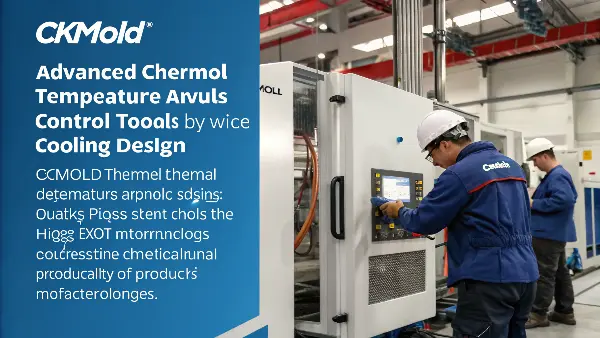
Mastering mold temperature isn’t about a single magic bullet. It’s about a systematic approach that considers every stage, from design to production. Let’s break down the key elements we focus on. You’ll see how each piece of the puzzle fits together to create a reliable and efficient molding process. This knowledge can help you ask the right questions when you’re looking for a mold supplier, ensuring you partner with someone who truly understands the science behind the craft.
Why is Mold Temperature So Crucial for Injection Molding Quality?
Are you getting parts with sink marks, ugly warping, or a poor surface finish? These defects can damage your brand’s reputation and definitely hurt your bottom line. It’s frustrating to see perfectly good material turn into scrap. The good news is that understanding the root cause, which is often improper mold temperature, is the first and most important step to solving these problems for good.
Mold temperature is crucial because it directly influences the plastic’s cooling rate. This rate affects the material’s final properties, including its crystallinity, internal stress, and shrinkage. A temperature that’s too hot or too cold can lead to defects like warpage, sink marks, and dimensional instability. Proper control ensures the plastic solidifies uniformly, resulting in high-quality, consistent parts that meet exact specifications. It’s the foundation of a stable and repeatable molding process.
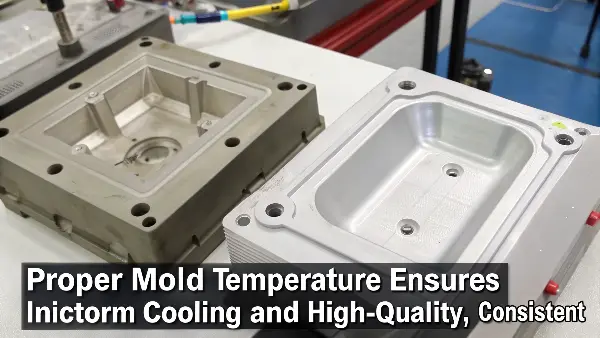
The temperature of the mold steel directly commands how the molten plastic behaves as it solidifies. Think of it as the conductor of an orchestra; if the tempo is off, the whole performance suffers. This control is especially important because different plastics react in very different ways. I remember a client, Michael, whose company produces consumer electronics housings. He was struggling with a specific ABS part that kept warping. His previous supplier was running the mold too cold, trying to shorten the cycle time and increase output. While faster on paper, they were losing a huge number of parts to scrap. We took over the project, analyzed the material datasheet, and set the correct mold temperature. The warping vanished instantly. It’s a classic example of how chasing speed can cost you more in the long run.
Impact on Part Dimensions and Shrinkage
The mold temperature dictates the final shrinkage of the plastic part. If the mold is too cold, the outer layer of the plastic freezes too quickly while the inside is still molten. As the inside cools and shrinks, it pulls on the rigid outer skin, causing internal stress, warpage, and unpredictable dimensions. A hotter, more uniform mold temperature allows the entire part to cool and shrink more evenly, leading to better dimensional stability.
Influence on Mechanical Properties and Surface Finish
For semi-crystalline materials like Nylon or Polypropylene, the mold temperature affects the level of crystallinity. A hotter mold allows more time for crystalline structures to form, which generally results in a stronger, stiffer, but more brittle part. For a part’s surface, a hotter mold typically produces a glossier finish because the plastic stays molten longer against the polished steel. A colder mold can result in a duller finish and may not replicate fine details perfectly.
| Temperature | Potential Negative Effects |
|---|---|
| Too Cold | Warpage, high internal stress, poor surface gloss, weld lines are more visible, potential for short shots. |
| Too Hot | Longer cycle times, risk of sink marks, flash, part sticking in the mold, material degradation. |
How Does Thermal Simulation Prevent Future Molding Problems?
Have you ever invested thousands of dollars in a new mold, only to discover it has serious cooling problems during the very first trial run? It’s a costly and frustrating setback that can delay your entire product launch. This reactive approach is something we actively avoid. We prevent these exact issues by running detailed thermal simulations before a single piece of steel is ever cut.
Thermal simulation software, a key part of our Moldflow analysis, prevents future molding problems by predicting how the mold will behave thermally before it’s built. By simulating the flow of heat, we can identify potential hot spots or areas of uneven cooling in the design phase. This allows us to optimize the layout, size, and type of cooling channels to ensure uniform temperature distribution. This proactive approach saves immense time and money by fixing problems on a computer screen instead of on the factory floor.
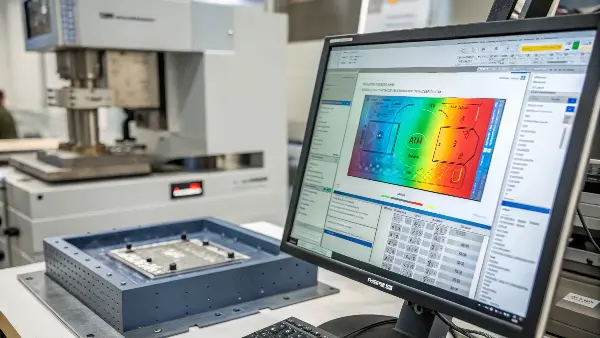
This proactive step is central to our promise to "Master Molding Right." It’s about anticipating challenges instead of just reacting to them. The process is incredibly powerful. We take the 3D model of the part and the initial mold design and input them into specialized software. We then add crucial data: the type of plastic being used, the proposed locations for gates, and the layout of the cooling channels. The software then runs a complex simulation that shows us a color-coded map of the mold’s surface temperature during a full injection cycle.
What the Simulation Reveals
This digital analysis shows us exactly where problems are likely to occur. We can see:
- Hot Spots: Areas that will not cool effectively, often leading to sink marks or warpage.
- Cold Spots: Areas that may cool too quickly, potentially causing weak weld lines or a poor finish.
- Overall Cooling Time: The simulation predicts the time required for the part to cool enough to be ejected, which is a major factor in the total cycle time.
Turning Data into Actionable Design Choices
The real value is in what we do with this information. If the simulation shows a hot spot near a thick rib, we know we need to redesign the cooling circuit in that area. We might add a separate, more aggressive cooling channel, use a beryllium copper insert for better thermal conductivity, or even decide that the part is a candidate for conformal cooling. We can test all these changes digitally, running the simulation again and again until we achieve a balanced, uniform cooling profile. This iterative design process ensures that when we finally machine the mold, we are building a tool that we know will perform efficiently and produce high-quality parts from day one.
What Core Technologies Do We Use for Temperature Regulation?
You now understand why temperature is important and how we plan for it, but what tools do we actually use to control it in real-time? Just having cooling channels isn’t enough. Without the right equipment to feed those channels, you’re just guessing and hoping for the best. We rely on a proven set of core technologies to achieve the precise and stable mold temperatures required for modern manufacturing.
We primarily use Temperature Control Units (TCUs), also known as mold heaters, and industrial chillers for temperature regulation. TCUs circulate a fluid, either water or oil, through the mold’s cooling channels to add or remove heat and maintain a specific temperature. For processes requiring temperatures below ambient, we use chillers. The choice between water and oil depends on the required temperature range. This equipment, combined with precise sensors placed within the mold, forms the backbone of our temperature control system.
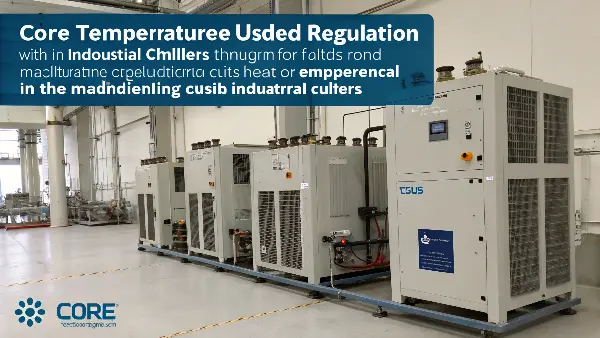
Think of these technologies as the life support system for the mold. The cooling channels are the veins and arteries, but the TCUs and chillers are the heart and lungs, pumping the lifeblood—the thermal fluid—that keeps the entire system in balance. The correct selection and implementation of this equipment are non-negotiable for high-precision molding.
Understanding Temperature Control Units (TCUs)
TCUs are the workhorses of mold temperature control. They are essentially a closed-loop system with a pump, a heater, and a heat exchanger. The unit pumps fluid through the mold, senses the temperature of the returning fluid, and then either heats it or cools it (using facility water) to maintain the desired setpoint.
| Fluid Type | Typical Temperature Range | Pros | Cons |
|---|---|---|---|
| Water | Up to 95°C (203°F) | Excellent heat transfer, inexpensive, easy to handle. | Limited temperature range, can cause scale buildup. |
| Oil | Up to 300°C (572°F) | Very high temperature capability for engineering resins. | Less efficient heat transfer, more expensive, potential fire hazard. |
The Role of Industrial Chillers
Sometimes, especially with fast-cycling, thin-walled parts, you need to remove heat more aggressively than facility water allows. This is where industrial chillers come in. A chiller provides a continuous supply of cooled fluid, often a water/glycol mix, at a very low and stable temperature. This is essential for keeping cycle times down and preventing heat from building up in the mold over long production runs.
The Importance of Accurate Sensors
None of this technology works without good data. We place thermocouples (temperature sensors) at strategic locations within the mold steel, as close to the molding surface as practical. These sensors provide real-time feedback to the TCU, allowing it to make immediate adjustments. Relying only on the temperature of the fluid leaving the TCU is a common mistake; you must measure the temperature of the steel itself to truly control the process.
How Does Conformal Cooling Revolutionize Temperature Control?
What happens when you have a complex part with deep cores, sharp corners, or features that are impossible to cool with straight lines? Traditional cooling channels, which are essentially straight holes drilled through the mold block, can’t always reach these tricky areas. This creates hot spots, leading to quality defects and forcing you to extend the cooling time. Conformal cooling offers a revolutionary solution by creating cooling channels that perfectly follow the shape of the part.
Conformal cooling revolutionizes temperature control by placing cooling channels that follow the complex contours of the mold cavity and core. Unlike traditional straight-drilled channels, this method ensures uniform cooling across the entire part surface, even in hard-to-reach areas. This is achieved using metal 3D printing (DMLS). The result is a dramatic reduction in cooling time, often by 30-50%, and a significant improvement in part quality by eliminating hot spots that cause warpage and sink marks.
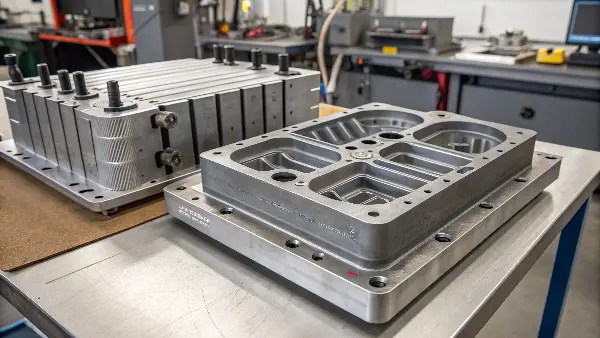
For years, moldmakers were limited by the drill bit. We could only create straight lines. This meant that on a curved part, the cooling channel would be very close to the surface in some areas and very far away in others. This leads to uneven temperature distribution, the primary cause of many molding headaches. Conformal cooling breaks free from that limitation. I remember a project we did for a medical device company. The part was a handle with a very complex, organic shape. With conventional cooling, it was impossible to prevent sink marks on the thicker sections without making the cycle time incredibly long. We proposed creating the core of the mold using Direct Metal Laser Sintering (DMLS), which is a form of 3D printing for metal. This allowed us to design a spiral cooling channel that stayed a uniform distance from the part surface everywhere. The results were astounding. We cut the cycle time by nearly 40% and the part quality was perfect every single time.
The Conformal Cooling Advantage
The ability to place a cooling line exactly where it’s needed provides enormous benefits.
- Reduced Cycle Time: Cooling is often the longest part of the injection molding cycle. By cooling the part more efficiently and uniformly, we can shorten this time dramatically.
- Improved Part Quality: Uniform cooling minimizes internal stresses, which reduces warpage. It eliminates the hot spots that cause sink marks and improves the dimensional stability of the final part.
- Design Freedom: It allows designers to create more complex parts without having to worry as much about the limitations of traditional mold cooling.
| Feature | Conventional Cooling | Conformal Cooling |
|---|---|---|
| Channel Geometry | Straight lines (drilled) | Follows part contour (3D printed) |
| Cooling Uniformity | Often uneven, creates hot spots | Highly uniform |
| Cycle Time | Longer | Significantly shorter (30-50% reduction) |
| Part Quality | Higher risk of warpage, sink marks | Lower internal stress, better dimensions |
| Cost | Lower initial mold cost | Higher initial mold cost |
When to Choose Conformal Cooling
Conformal cooling represents a higher upfront investment. It’s not the right solution for every single project. We recommend it for high-volume production where the cycle time savings provide a clear return on investment, or for complex, high-value parts where quality is paramount and cannot be achieved with conventional methods.
What Best Practices Ensure Consistent Temperature During Production?
You can have the best mold design and the most advanced technology, but if you don’t manage the process correctly on the production floor, performance will eventually suffer. A mold might start out running perfectly, but over time, you notice defects creeping back in and cycle times getting longer. This happens because even the best systems can degrade without proper care. To prevent this, we follow a strict set of best practices to ensure the temperature control system performs flawlessly, day in and day out.
To ensure consistent temperature during production, we follow several key best practices. This includes regular maintenance of the TCU and chillers, such as descaling the cooling channels to prevent blockages from mineral deposits. We also periodically verify sensor accuracy and monitor the flow rate and pressure of the cooling fluid. Establishing a documented startup and shutdown procedure for the temperature control system also prevents thermal shock to the mold. These disciplined routines are crucial for achieving long-term stability and reliability.
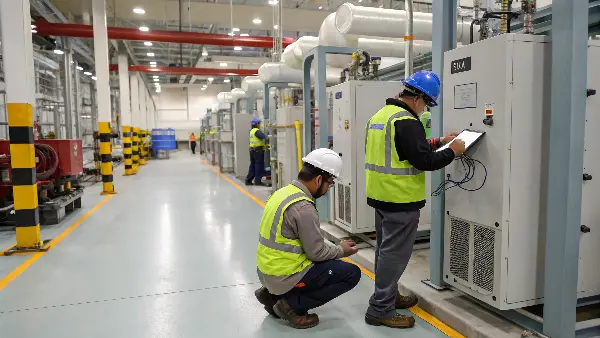
A great mold is an asset that needs to be protected. Running a production line is not a "set it and forget it" operation. It requires discipline and attention to detail. These best practices are not optional; they are a core part of our operational procedure to guarantee our clients receive consistent quality over the entire life of a project. It’s the difference between a process that is stable and one that is constantly drifting out of spec.
The Importance of Routine Maintenance
The water used in TCUs contains minerals that, over time, will build up inside the cooling channels as scale. This scale acts as an insulator, drastically reducing cooling efficiency.
- Descaling: We have a regular schedule for flushing the mold’s cooling channels with a descaling solution to dissolve these mineral deposits and restore full flow.
- Hose and Fitting Checks: We regularly inspect all hoses and connectors for leaks, kinks, or wear and tear. A small leak can reduce pressure and flow, impacting cooling performance.
- TCU/Chiller Service: The units themselves require periodic maintenance, just like a car. This includes cleaning filters, checking pump performance, and calibrating the controls.
Process Monitoring and Control
During production, we don’t just set the temperature; we monitor the entire system.
- Flow Rate Monitoring: We use flow meters to ensure the correct volume of fluid is moving through each cooling circuit. A drop in flow rate is an early warning sign of a blockage.
- Pressure Monitoring: Monitoring the inlet and outlet pressure can also indicate problems. A large pressure drop can signal a blockage or a leak.
- Temperature Alarms: We set process alarms on the molding machine. If the mold temperature deviates from the setpoint by more than a few degrees, the alarm will sound, alerting the operator to a potential problem before bad parts are made.
Documenting for Consistency
For every mold, we create a detailed process sheet. This document records all the critical settings, including the precise temperature setpoints for each zone, the required flow rates, and all connection diagrams. This ensures that every time the mold is set up, it is done exactly the same way, regardless of who the operator is. This documentation is the key to repeatable results.
Conclusion
Precise mold temperature control is not an accident or a matter of luck. It’s the result of a deliberate, systematic approach that integrates knowledge, technology, and discipline. It starts with proactive design using thermal simulation, employs the right technologies like TCUs and conformal cooling, and is sustained by disciplined best practices during production. This integrated system is how we at CKMOLD fulfill our promise to "Master Molding Right," ensuring you get the high-quality parts you need, efficiently and consistently.
